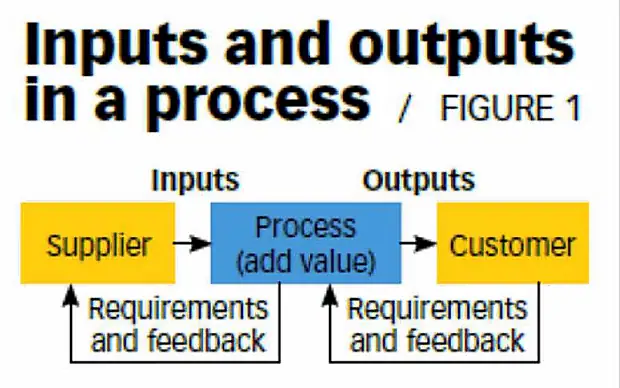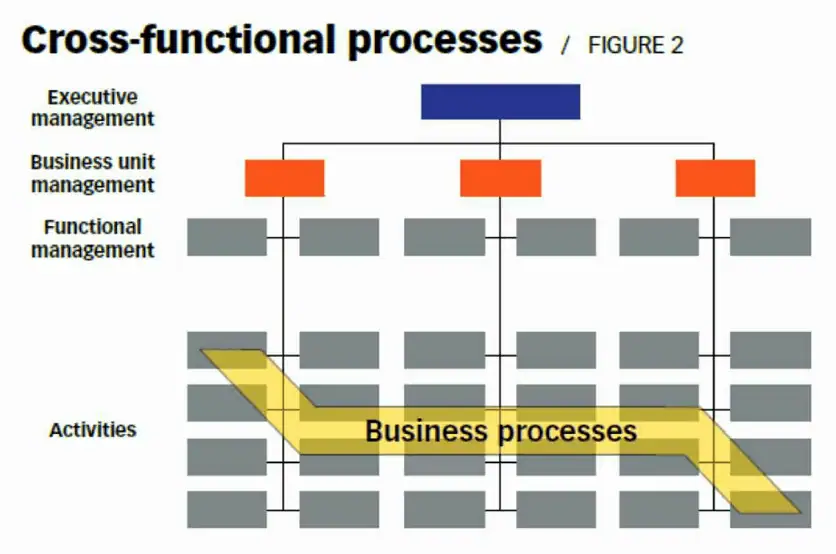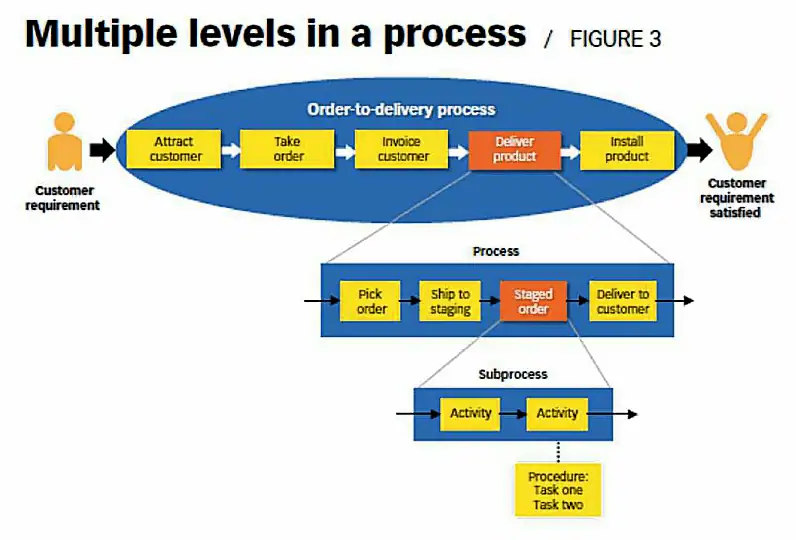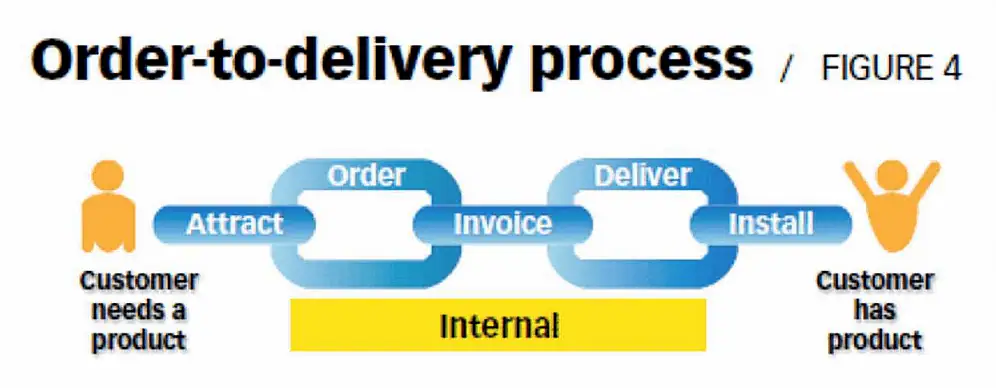
- Inputs and outputs in a process
- Cross functional processes
- Multiple levels in a process
- Order-to-delivery process
Business process management (BPM) is no different. It’s all about controlling the process to control the outcome. It allows us to manage our processes effectively and efficiently, day to day, to delight customers.
Five BPM pillars form the foundation for any organization to move forward in a continuous improvement journey:
- Identifying top priority, critical processes.
- Validating customer requirements.
- Documenting the processes.
- Developing process measurements.
- Managing and improving the processes.
First, a definition of process: One dictionary calls it “a series of actions that produce something or that lead to a particular result”. Looking at what Six Sigma refers to as a suppliers inputs, process, outputs and customers (SIPOC) diagram (see Figure 1), you see processes have inputs and outputs: Take an input from a supplier, add value to it and deliver the output to the customer.

It is important to understand customers’ requirements and receive feedback on how you’re doing in meeting those requirements. In addition, the suppliers must understand customer requirements, and customers must provide feedback on how suppliers are doing in meeting those requirements.
Most processes are cross functional (see Figure 2). Even within one organizational function, different sections or individuals may be involved. Because of this, it is important that someone be responsible for looking at and managing the entire process. That person might come from one of the functions involved in the process or another area indirectly involved in any of the process activities.

Processes usually have multiple levels (see Figure 3). An activity at one level becomes a process at the next lower level. A process should be described in simple terms. Typically, a process is made up of five to eight activities, but it can have more activities at the lowest level.

At each level, someone owns the process, therefore, the process should be at a level of detail that reflects the activities the process owner will personally follow. Remember, processes tell you what you have to do; procedures or work instructions tell you how to do it.
When you look at the order-to delivery process (see Figure 4), remember that the process is like a chain. If one of the activities is not working properly, it’s like breaking a link in a chain, and the customer may not get the product or service expected.

Identify Critical Processes
An organization cannot work on all its processes at the same time, therefore, the first thing to do is identify the top priority or critical processes. These are certain processes that are typically operational and at the core of delivering a product or service to external customers. A problem with a top priority or critical process directly results in not meeting customer requirements or expectations.
Eventually, all critical processes must be addressed. Which process to review first can be determined by:
- Evaluating the criticality of each process to satisfying customers and achieving organizational goals.
- Evaluating which processes are not performing as expected.
Determining which one of your processes is top priority is extremely important. Typically, you should look at what is most broken or the one receiving the most top-level scrutiny.
Validate customer requirements
There are two types of customers: external and internal. We usually consider external customer requirements, but it is just as important to understand who your internal customers are and their requirements. Internal customers can include the next process customer (the person internally who receives what you do), other functional areas and executive management.
It is necessary to review customer requirements with your customers to be sure they are specific, measurable, unchanged, and can be provided in a satisfactory format and time frame. This may involve negotiation with the customer if the criteria cannot be met.
The requirement becomes valid only after it’s agreed the customer need can indeed be satisfied, and you agree to satisfy it. The same criteria apply in validating requirements for both internal and external customers.
In some organizations, other key stakeholder requirements may be as important as customer requirements. In a healthcare setting, for example, the needs of physicians, families and insurance companies can play a significant role in how a hospital serves its primary customers: patients. In education, requirements of parents and other stakeholders (for example, businesses and higher learning institutions) might affect the way a school teaches its primary customers: students.
Download our e-book
Download our free e-book to discover how GQ Interim can transform your business with expert leadership solutions!
Conclusion
An organization also must carefully consider its suppliers and partners. To provide products and services that meet customer expectations and requirements consistently, everyone must understand the end-to-end system and where he or she fits into the bigger picture. It is important to assess how well the individual pieces contribute to delivering products and services overall.
Interested in Interim Expert?
Discover how interim management can dramatically increase the efficiency of your business. Get in touch with our team to learn how working with GQ Interim will improve your company.
- Get started within few days
- Database of 10 000+ consultants
- Solving crucial problems of your business
- Custom solutions for your business needs
- Proven results with measurable impact
Related articles

- A balanced scorecard example demonstrates how organizations can measure more than just financial performance. Developed by Robert Kaplan and David Norton, the balanced scorecard tracks goals across finance, customers, internal processes, and learning & growth. By aligning these perspectives, it ensures that daily operations support long-term strategy and sustainable growth.

- The Theory of Constraints (TOC) is a structured approach to improving organizational performance by focusing on the single most limiting factor—the constraint. Whether it’s a production bottleneck, market demand, or a sales conversion gap, TOC answers three core questions—what to change, to what to change, and how to cause the change—and drives continuous improvement through five disciplined steps: identify, exploit, subordinate, elevate, and repeat.

- Software quality assurance ensures that software consistently meets stakeholder needs by preventing defects and validating that products align with defined quality attributes (e.g., reliability, security, performance). Blending defect management practices with standards-based quality models like ISO/IEC 25010 helps teams plan, measure, and continuously improve quality throughout the lifecycle.

- During our jobs we meet very often with many symbols and shortcuts or abbreviations e.g. FMEA, PPAP, CC, SC etc. When I did my first internal audit at work I had to also check the implementation of CE marking. Previously I have done the research what is this CE marking to not be absolutely lost in this area. So what is it and how is itused?
